Cyclamen are beautiful, flowering plants that bring a pop of color to any indoor space or garden. With their heart-shaped leaves and stunning flowers, they are a favorite among plant enthusiasts. However, they do require specific care to thrive. In this detailed guide, we will explore how to care for cyclamen, covering their light, water, soil, temperature, humidity, fertilization, pruning, pest management, common issues, and even propagation techniques.
Understanding cyclamen
Cyclamen belong to the Primulaceae family and are native to the Mediterranean region. They are known for their distinctive flowers, which come in various colors, including white, pink, red, and purple. Cyclamen are typically grown as houseplants, but they can also be cultivated outdoors in suitable climates.
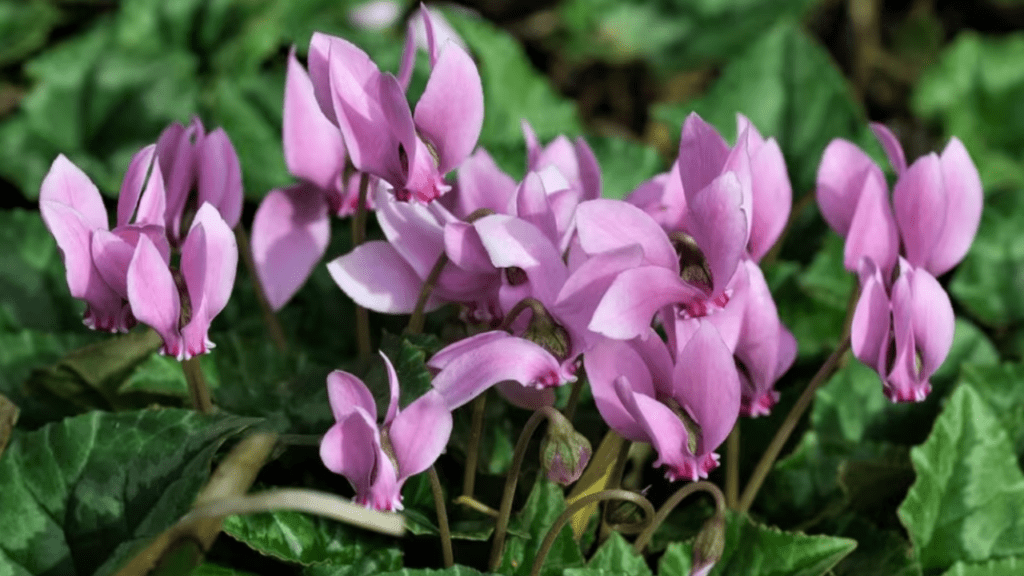
Types of cyclamen
- Cyclamen persicum: The most commonly grown type, known for its large, colorful flowers. It is often sold as a houseplant and is popular for indoor decoration.
- Cyclamen hederifolium: A hardy species that can be grown outdoors in temperate climates. It produces smaller flowers and has ivy-shaped leaves, making it a lovely addition to outdoor gardens.
- Cyclamen coum: Another outdoor species that blooms in early spring, featuring rounded leaves and various flower colors. It is known for its resilience and ability to thrive in different conditions.
- Cyclamen mirabile: This type has unique marbled leaves and is also suitable for outdoor gardens in certain climates. Its striking appearance makes it a sought-after choice for collectors.
How to care for cyclamen – Choosing the right location
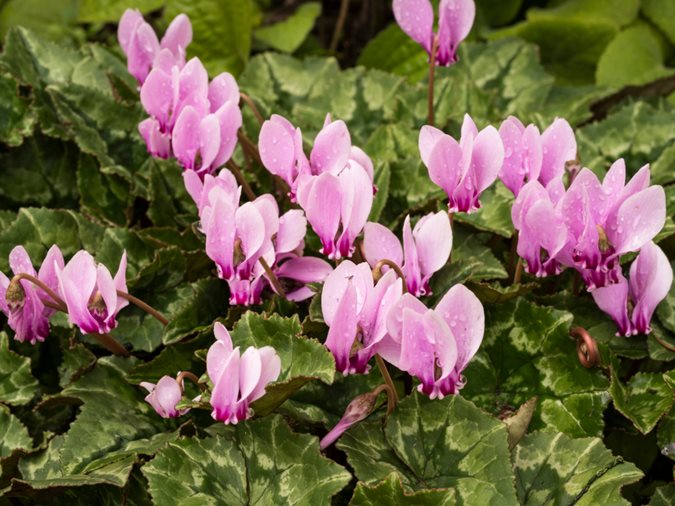
Here are the details:
Light requirements
- Indirect light: Cyclamen prefer bright, indirect light. Direct sunlight can scorch their leaves and cause the flowers to wilt. Place them near a window with filtered light or in a well-lit room. East-facing windows are ideal, as they receive gentle morning sunlight.
- Avoid dark areas: While cyclamen can tolerate lower light conditions, prolonged exposure to darkness may lead to weak growth and fewer blooms. If you notice the plant becoming leggy or leaning towards the light source, it may need to be relocated to a brighter spot.
Temperature preferences
- Ideal temperature range: Cyclamen thrive in cooler temperatures, ideally between 60°F to 70°F (15°C to 21°C) during the day and slightly cooler at night. They are not suited for hot environments.
- Avoid heat sources: Keep cyclamen away from heat sources such as radiators, heaters, or drafty windows, as excessive heat can stress the plant and reduce flowering. If your home gets particularly warm, consider placing a small fan nearby to circulate air without blowing directly on the plant.
Watering cyclamen
Proper watering is crucial for the health of cyclamen, as they are sensitive to both overwatering and underwatering.
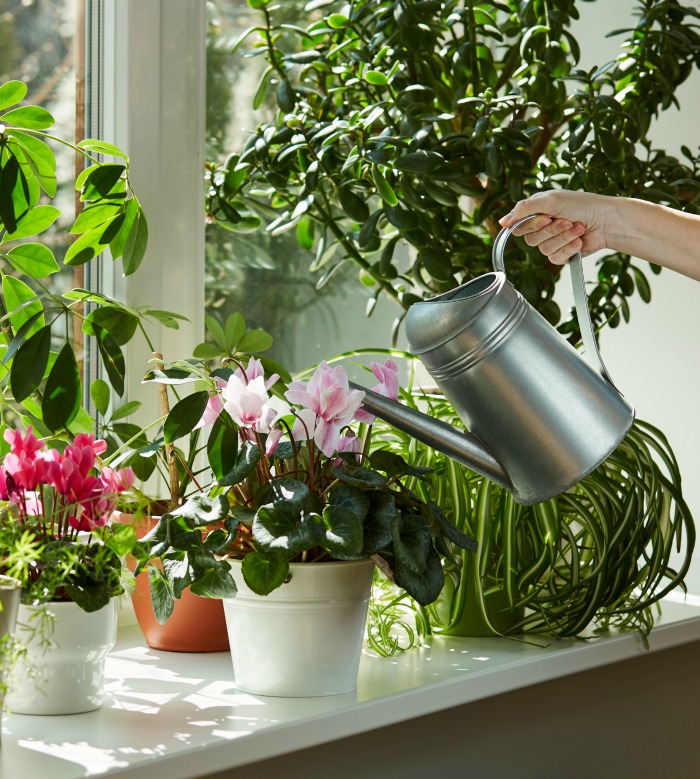
Watering techniques
- Check soil moisture: Water cyclamen when the top inch of soil feels dry to the touch. This typically means watering every 1-2 weeks, but it can vary depending on environmental conditions.
- Watering method: Use room-temperature water and water at the base of the plant to avoid getting water on the leaves and flowers. This helps prevent rot and fungal diseases. If using tap water, let it sit out for a few hours to allow chlorine to dissipate.
- Avoid soggy soil: Cyclamen are susceptible to root rot, so ensure that the soil is well-draining. If the leaves begin to droop or yellow, it may be a sign of overwatering.
Signs of watering issues
- Underwatering: If the leaves are wilting or becoming crispy, it indicates that the plant is not getting enough water. Adjust your watering schedule to provide more moisture.
- Overwatering: Yellowing leaves and mushy stems are signs of overwatering. If you suspect root rot, gently remove the plant from its pot and inspect the roots. Trim away any rotten roots and repot in fresh, well-draining soil.
Soil requirements
Cyclamen thrive in well-draining soil that retains some moisture but does not become waterlogged.
Soil mix
- Potting mix: Use a high-quality potting mix that contains perlite or vermiculite for better drainage. You can also create a custom mix using equal parts peat moss, perlite, and pine bark to provide the necessary aeration and moisture retention.
- Repotting: Repot cyclamen every 1-2 years, ideally in late summer or early fall when the plant is dormant. Choose a pot that is slightly larger than the previous one, and refresh the soil to provide new nutrients. When repotting, be careful not to bury the tuber, as this can lead to rot.
Drainage
- Container selection: Ensure that the pot has adequate drainage holes to allow excess water to escape. Poor drainage can lead to root rot and other complications.
- Layering: Consider placing a layer of small stones or broken pottery at the bottom of the pot before adding soil to enhance drainage further.
Fertilization
Cyclamen do not require a lot of fertilization, but providing nutrients during the growing season can promote healthier plants and more blooms.
Fertilization schedule
- When to fertilize: Begin fertilizing cyclamen in the spring when they start to grow actively. Fertilize every 4-6 weeks during the growing season to provide essential nutrients.
- Fertilizer type: Use a balanced, water-soluble fertilizer with a ratio like 10-10-10 or a diluted liquid fertilizer. Avoid high-nitrogen fertilizers, which can encourage leaf growth at the expense of flowers.
Application method
- Dilution: Always dilute the fertilizer to half strength to avoid burning the roots. Strong fertilizers can damage young roots, especially in delicate plants like cyclamen.
- Application: Apply fertilizer to damp soil to prevent root burn. Water the plant thoroughly after fertilization to help the nutrients penetrate the soil. If your cyclamen is dormant, hold off on fertilizing until new growth appears.
Humidity and air circulation
Cyclamen enjoy moderate humidity levels, which can be enhanced in indoor environments.
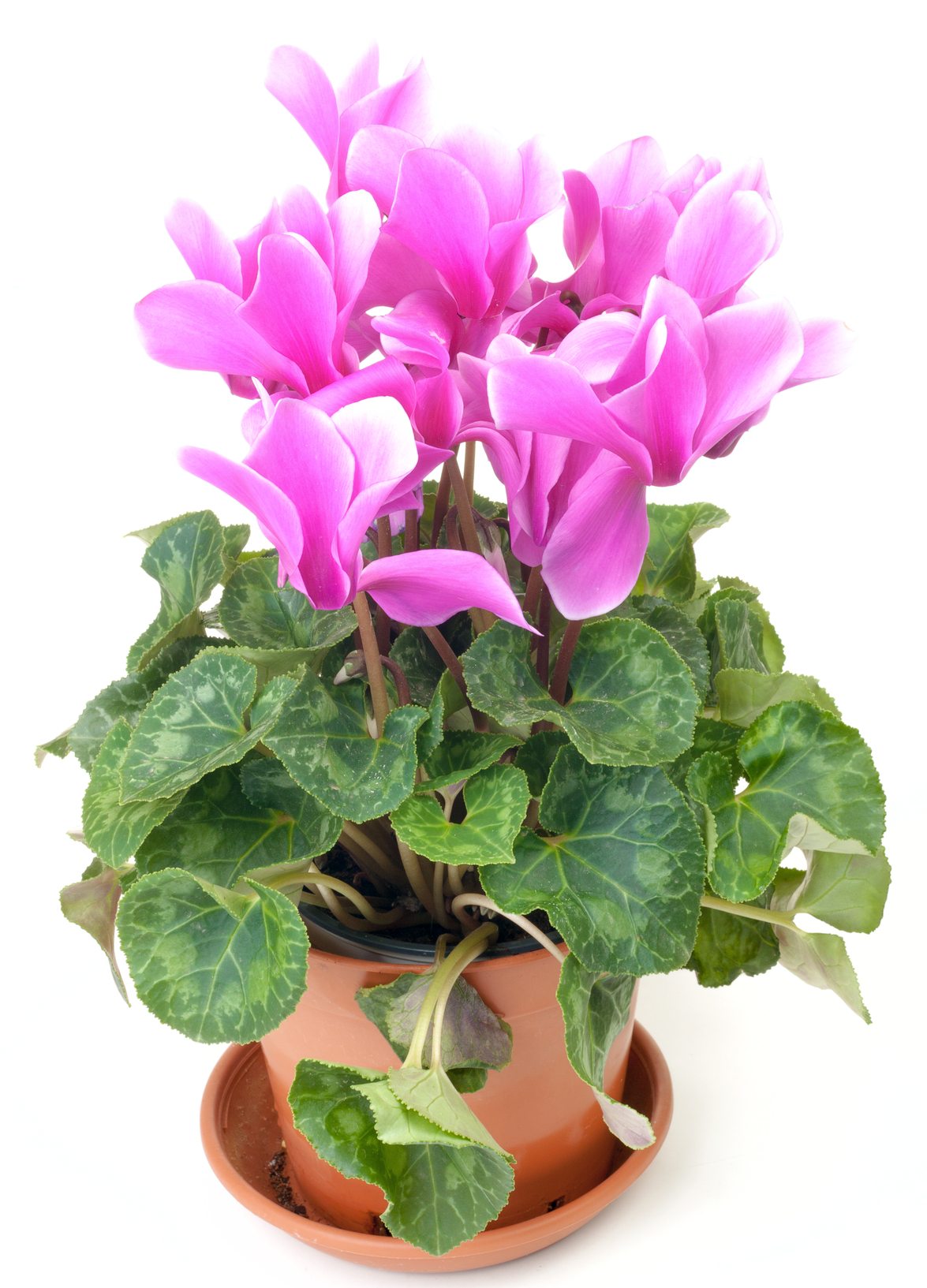
Humidity requirements
- Humidity levels: Aim for humidity levels between 40% to 60%. If your home is particularly dry, especially in winter, consider using a humidifier or placing a tray of water with pebbles near the plant to increase humidity.
- Avoid misting: While it may seem beneficial to mist cyclamen, excessive moisture on the leaves can promote fungal diseases. It’s best to increase humidity through indirect methods rather than direct misting.
Air circulation
- Good airflow: Ensure adequate air circulation around your cyclamen to prevent mold and pests. Avoid crowding plants together, and if necessary, use a small fan to improve airflow without directly blowing on the plant.
- Location: Placing cyclamen in a location with good airflow can help prevent issues like powdery mildew and root rot, which thrive in stagnant conditions.
Pruning and deadheading
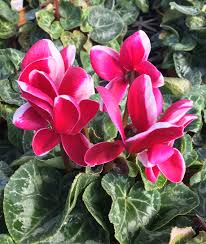
Pruning cyclamen is essential to maintain their health and promote new growth.
Deadheading flowers
- Remove spent blooms: Regularly deadhead spent flowers by pinching them off at the base of the stem. This encourages the plant to produce more blooms and prevents energy from being wasted on dying flowers.
- Timing: Deadhead flowers as soon as they begin to wilt. This is especially important during the blooming season to maintain the plant’s appearance and vigor.
Leaf care
- Remove yellow leaves: If leaves become yellow or wilted, gently remove them to maintain the plant’s health and appearance. This also helps prevent disease by reducing the risk of fungal infections.
- Maintain leaf shape: Avoid excessive handling of the leaves, as they can be delicate. If you notice any damaged leaves, prune them away to encourage new, healthy growth.
Pest management
Cyclamen can be susceptible to pests, which can cause stress and damage to the plant.
Common pests
- Spider mites: These tiny pests can cause leaf discoloration and stippling. Increase humidity and use insecticidal soap to manage infestations. Regularly check the undersides of leaves, as spider mites often hide there.
- Aphids: Small, soft-bodied insects that can cluster on new growth and flowers. Remove them with a strong stream of water or treat with insecticidal soap. You can also introduce natural predators like ladybugs to help control aphid populations.
- Mealybugs: These pests appear as white, cottony masses on the plant. Remove them manually with a cotton swab dipped in alcohol or treat with insecticidal soap. Be vigilant, as mealybugs can spread quickly if not addressed.
Prevention
- Regular inspection: Check your cyclamen regularly for signs of pests. Early detection is key to preventing infestations. Look for discoloration, sticky residue (honeydew from aphids), or webbing (from spider mites).
- Cleanliness: Keep the area around your cyclamen clean and free from debris. This helps deter pests and reduces the risk of disease. Remove any dead leaves or fallen flowers promptly.
Common issues with cyclamen
Even with proper care, cyclamen may encounter several common issues. Here are some signs to look out for and their solutions:

Leaf yellowing
- Causes: Yellowing leaves can result from overwatering, nutrient deficiencies, or low light conditions. It’s essential to assess the plant’s environment and care routine.
- Solutions: Check the watering schedule and adjust as necessary. If the plant is in low light, consider moving it to a brighter location. Fertilizing may also help if a nutrient deficiency is suspected, but be cautious not to overdo it.
Drooping leaves
- Causes: Drooping leaves are often a sign of underwatering or excessive heat. Environmental stress can also contribute to this issue.
- Solutions: Check the soil moisture and water if needed. Ensure the plant is in a suitable temperature range away from direct heat sources. If the leaves do not perk up after watering, reassess your care practices.
Failure to bloom
- Causes: If your cyclamen is not blooming, it may be due to insufficient light, lack of nutrients, or being too warm. Stress from pest infestations can also hinder blooming.
- Solutions: Ensure the plant is receiving adequate light and consider fertilizing if it hasn’t been done recently. If the environment is too warm, move the plant to a cooler area. Ensure that it is getting enough water without overdoing it.
Dormancy
Cyclamen have a natural dormancy period, which usually occurs in the summer months.
Recognizing dormancy
- Signs of dormancy: During dormancy, cyclamen will often lose their leaves and stop blooming. This is a natural part of their growth cycle and typically happens in late spring to early summer.
- Care during dormancy: Reduce watering significantly during this period, allowing the soil to dry out between waterings. Place the plant in a cool, dark location until new growth appears. It’s crucial to avoid overwatering during this time, as the tuber can rot.
Reviving dormant cyclamen
- Reintroduction to light: As fall approaches and temperatures begin to cool, gradually reintroduce the plant to light and resume regular watering. Start with indirect light and gradually increase exposure to prevent shock.
- Fertilization: Begin fertilizing again once you see new growth to encourage blooming. Use a balanced fertilizer at half strength to support the plant as it emerges from dormancy.
Propagation
Propagating cyclamen can be a rewarding experience for plant enthusiasts. Here’s how to do it effectively:
Methods of propagation
- Seed propagation: Cyclamen can be grown from seeds, but this method takes time and patience. Collect seeds from the pods after the flowers have faded. Plant them in a seed-starting mix and keep the soil consistently moist. Germination can take several weeks to months, so be prepared for a long wait.
- Tuber division: During the dormant period, you can divide the tubers to propagate new plants. Gently remove the plant from its pot, separate the tubers, and replant them individually in fresh soil. Ensure each tuber has healthy roots attached.
Care for new plants
- Initial care: Provide new plants with indirect light and moderate humidity. Keep the soil moist but not soggy, as young plants are still establishing their root systems.
- Gradual adjustment: As the new plants grow, gradually acclimate them to brighter light and regular care. Monitor their growth closely and address any issues that arise.
Conclusion
Here are the details “how to care for cyclamen”. Caring for cyclamen can be a delightful experience, rewarding you with beautiful blooms and lush foliage. By understanding their specific light, water, soil, and temperature requirements, you can create an ideal environment for these stunning plants. Regular maintenance, such as deadheading, pruning, and pest management, will help ensure your cyclamen remain healthy and vibrant.

Related articles
Top 5 Spring Tree Pests: Identifying and Managing Common Threats
How to Grow Virginia Creeper: A Complete Guide
How to care for cyclamen from the expert
Detailed instructions: How to care for propagated plants
Understanding tree diseases: Identification, prevention, and treatment
Detailed instructions: How to care for fruit trees
Detailed instructions how to grow winter vegetables
How to propagate an aloe plant: a detailed guide to the methods